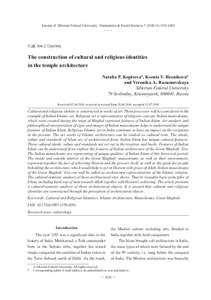The construction of cultural and religious identities in the temple architecture
Скачать файл:
URI (для ссылок/цитирований):
https://elib.sfu-kras.ru/handle/2311/71770Автор:
Koptseva, Natalia P.
Reznikova, Ksenia V.
Razumovskaya, Veronika A.
Копцева, Н.П.
Резникова, К.В.
Разумовская, В.А.
Дата:
2018-07Журнал:
Журнал Сибирского федерального университета. Гуманитарные науки. Journal of Siberian Federal University. Humanities & Social Sciences;2018 11 (7)Аннотация:
Cultural and religious identity is constructed in works of art. These processes will be considered in the example of Indian Islamic art. Religious art is representative of religions concept. Indian mausoleums, which were created during the reign of Mughal represent features of Indian Islam. Art analysis and philosophical interpretation of signs and images of Indian mausoleums helps to understand the unique features of Indian Islam. Religious Islamic art in India continues to have an impact on the recipients in the present. The art works of Islamic architecture can be studied as cultural texts. The ideals, values and standards of Islam are of architectural form. Indian Islam has unique cultural features. These cultural ideals, values and standards not set out in the treatises and books. Features of Indian Islam can be understood if we explore the features of Indian architecture of the Great Mughals’ Era. The Indian mausoleums are representing of unique qualities of Indian Islam of this historical period. The inside and outside interior of the Great Mughals’ mausoleums, as well as their environment, represent together the fact of achieving Heaven and the process itself, as well as the guide for people beholding the architecture, which would help to get in Heaven with grace of Allah. Indian mausoleums of the Great Mughals’ Era can well be called as architecture representatives of the Islamic religion. The cultural-semiotic analysis of these architectural sites shows. That its visualize basic principles of Islam, including hard way of man towards Allah together with Heaven’s achieving. The article presents a cultural-semiotic analysis of these architectural objects. It is proved that cultural and religious identities are constructed through the perception of architectural objects Культурная и религиозная идентичность конструируется в произведениях искусства.
Рассмотрим эти процессы на примере индийского исламского искусства. Индийские мавзолеи, созданные во времена правления Великих Моголов, репрезентируют особенности
индийского ислама. Художественный анализ и философская интерпретация знаков и изображений индийских мавзолеев помогают понять уникальные особенности индийского ислама. Религиозное исламское искусство в Индии продолжает оказывать влияние на реципиентов в настоящем времени. Художественные произведения исламской архитектуры
можно рассматривать как культурные тексты. Идеалы, ценности и стандарты ислама
имеют архитектурную форму. Индийский ислам обладает уникальными культурными особенностями. Эти культурные идеалы, ценности и стандарты не изложены в трактатах
и книгах. Особенности индийского ислама можно понять, если мы проанализируем особенности индийской архитектуры эпохи Великих Моголов. Индийские мавзолеи репрезентруют уникальные качества индийского ислама в этот исторический период. Внутренний
и внешний облик мавзолеев Великих Моголов, а также окружающая среда, куда они вписаны, представляют собой совокупность фактов достижения Небес и самого этого процесса, а также выступают руководством для людей, созерцающих архитектуру, которые
помогут попасть на Небеса с помощью Бога. Индийские мавзолеи эпохи Великих Моголов
вполне можно назвать репрезентантами архитектуры исламской религии. Представлен
культурно-семиотический анализ этих архитектурных объектов. Доказано, что культурная и религиозная идентичности конструируются с помощью восприятия архитектурных
объектов.

